Now to the second blog for the week to clear the decks for Professor Alan Stewart’s lecture on Tuesday 21 November at 5pm in The Michael Berry Lecture Theatre, Old Sessions House, Longport CT1 1PL. This is entitled ‘The First Coming of the Strangers: An Experiment in Elizabethan Immigration’ and is a free, open lecture and booking is not required. We hope to see you there.
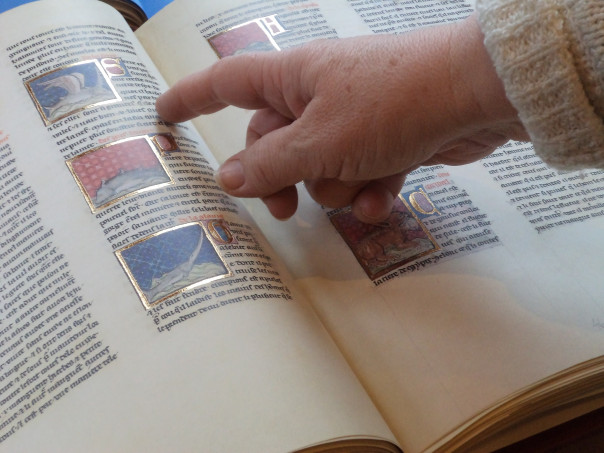
So to today, and Dr Diane Heath’s Medieval Animals Heritage ‘Beastly Latin’ group and a few others met in the Cathedral Lodge for a friendly workshop on the unicorn. As Diane said, an especially appropriate fabulous beast as we come up to Advent and Christmas, but more on that anon. Having fortified ourselves with refreshments, the group were introduced to the unicorn by Diane, who provided a ‘tour’ through the various illustrations of the unicorn in a wide range of medieval bestiaries, including from Christ Church Priory and St Augustine’s Abbey. Looking at these images, what was interesting and provoked discussion was the transition of the unicorn from a goat-like animal to one that resembles a horse, which seemingly took place in the first half of the 14th century, albeit like many such transitions it was not clearcut and while some illustrators had made this change, in other bestiaries the illustrator continued to keep to the older format.
This nicely led into the first workshop session where, using Diane’s basic translation, the group of expert Latinists went through the text word by word and line by line to produce an accurate and readable translation that takes account of 21st-century sensibilities and knowledge. This approach was applied to both the bestiary description of the unicorn and its relationship with specific humans, including how it might be captured successfully, as well as the theological, allegorical and moral meanings which begin with the premise that the story of the unicorn and its capture is symbolic of Christ, his birth (born of the Virgin Mary) and death (as illustrated in the many texts as the unicorn is speared by the hunters). It was exceedingly interesting and informative to listen to Charles, John, Sonya, Trish and Diane as they discussed the various points, as well as seeing how the writer/copyist had built up his similitude through a range of biblical sources to provide his deeper meanings for his presumably monastic audience. Consequently, it seems appropriate to end this description of the workshop with the last line “It was well done to speak about the Unicorn in this way.”
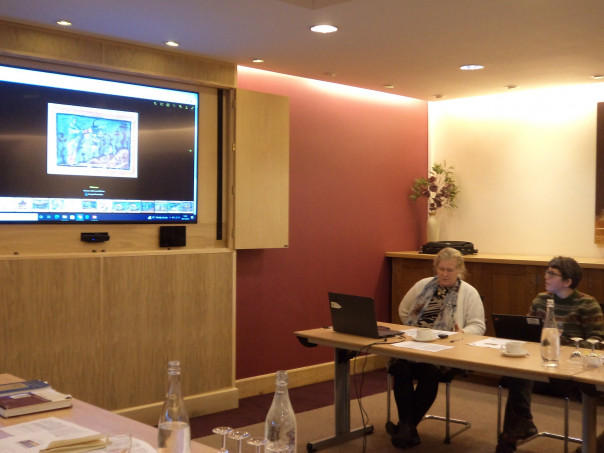
Before breaking for lunch, Dr Trish Stewart provided a brief overview of the history and make-up of the bestiary. As she said, while most of these texts are in Latin, there are surviving examples in several vernacular languages, and even though they are often seen as an English phenomenon, the bestiary can be found in France and as far east as eastern Europe. Moreover, they were produced from the late 10th century through to the 16th century, and while some were illustrated, including some de luxe manuscripts, others were not, and one of those from Christ Church Priory’s scriptorium has unfinished ie line drawings, not coloured illustrations. They are also found with a range of other texts, from sermons to material on the natural world, to medicinal pieces, while others have associated texts on birds and/or trees.
Additionally, the bestiary was not a single text and included among the changes over time is the level of incorporation of the early Physiologus and the slightly later work of Isidore of Seville. Generally, the later bestiaries are longer, and while at no stage was the intention to separate the religious from the non-religious, being intrinsically bound together in the various animal descriptions, again the later ones are seen as placing more emphasis on the bestiary as a moral rather than biblical teaching aid. One result of this is that bestiaries are now classified by scholars as belonging to a family – from one to three, and the one being used by the ‘Beastly Latinists’ is a first family bestiary. Today it is a large manuscript at the British Library that was seemingly produced by or for an abbot in the early 13th century at St Peter’s Abbey in Gloucester.
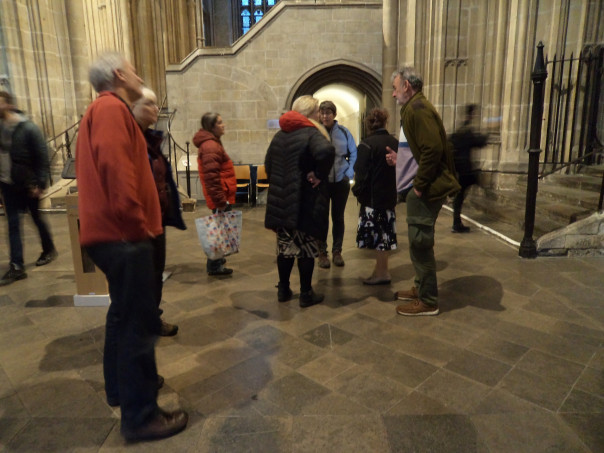
As Trish then went on to point out, bestiaries have fascinated scholars over the centuries, albeit some Victorians were very dismissive on the grounds of accuracy, while certain writers were far more interested in the bestiary’s literary credentials, not as a natural history text. The 20th century brought a reassessment, although again there were different approaches and stances, but a general down-grading of the importance of the moral aspect of the text. More recently ideas have changed again, and these days there is a strong belief among scholars that the bestiary should be seen as closely as we can to how it would have been viewed in the Middle Ages. Thus, cultural memory is vital, and the bestiary is valued as giving insights into how medieval society would have seen the animals as a route to the Creator – God, that is there was no tension between the natural world and religion – they were one and the same.
This set us up beautifully for an excellent lunch – I must mention the cheesecake – before we followed Diane over to the cathedral to explore the range of animals in St Anselm’s crypt, including the various side chapels, before also visiting the Trinity Chapel. The animal carvings are brilliant and if you don’t know them and live within range of Canterbury, they are most definitely worth a visit, as well, of course, the cathedral more generally. Albeit who can resist the lion with the handle-bar moustache, or the fabulous dragons, or the music-making asses.
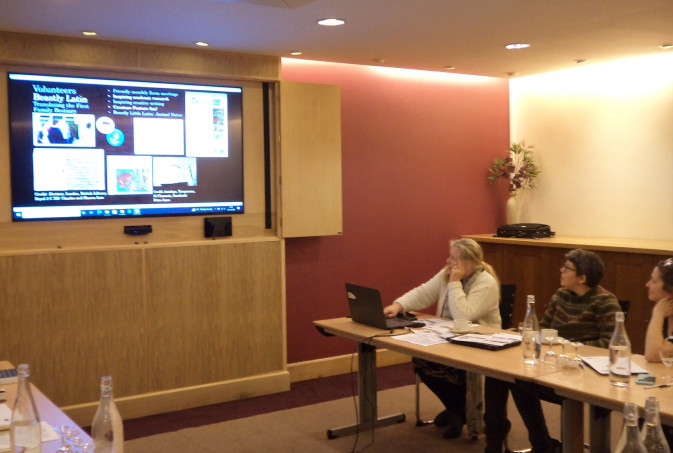
Returning to the Cathedral Lodge, Diane then provided a summary of all the activities that the Medieval Animals Heritage project has accomplished over the last year for the benefit of the SEND children and their families. Many of these events have featured in the CKHH blog, and the final report and accounts to the Heritage Lottery Fund as sponsors of the project is about to be submitted by Diane, Martin Crowther and Dr Pip Gregory as project leads.
The expert Latinists in the second workshop made light work of the ‘Etymology’ of the unicorn. However, there was some discussion about certain phrases but as the text will be revisited again before the team get to the publication stage, this was left to a future date.
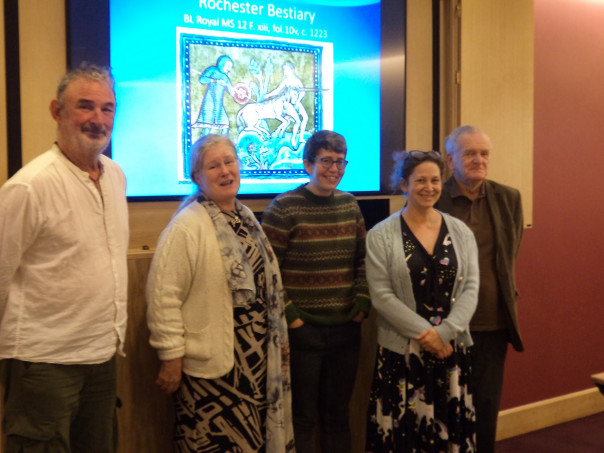
Thus, having started at 11am in daylight we finished in darkness at 5pm after a very interesting and enjoyable day, and the Beastly Latinists, led by Diane and Trish, will be back meeting online in late January for their next fabulous beast.
 Centre for Kent History and Heritage
Centre for Kent History and Heritage Sheila Sweetinburgh
Sheila Sweetinburgh 1754
1754


Great blogpost as usual Sheila… and what a fascinating day. Who knew that unicorns started off as small goat-like creatures? And an exploration of the carved beasts menagerie which is the Canterbury Cathedral Cathedral crypt is always a joy! A big thank you to Diane, Pip, Trish and the Beastly Latinists for all their excellent work as part of the Medieval Animals Heritage project!
Thanks Martin, and yes, many thanks to all concerned.